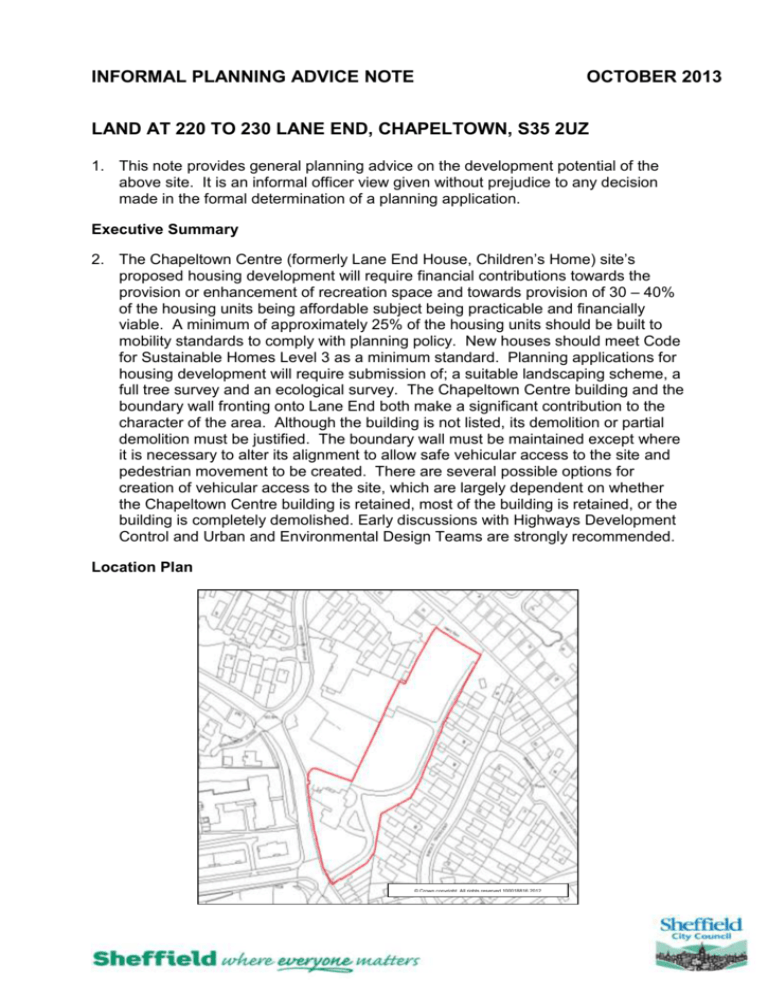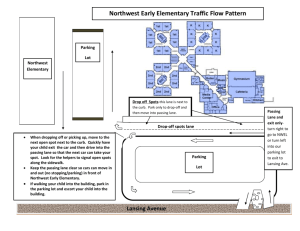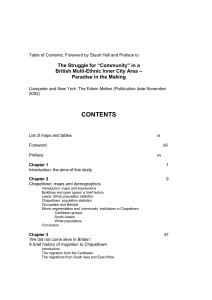
INFORMAL PLANNING ADVICE NOTE
OCTOBER 2013
LAND AT 220 TO 230 LANE END, CHAPELTOWN, S35 2UZ
1. This note provides general planning advice on the development potential of the
above site. It is an informal officer view given without prejudice to any decision
made in the formal determination of a planning application.
Executive Summary
2. The Chapeltown Centre (formerly Lane End House, Children’s Home) site’s
proposed housing development will require financial contributions towards the
provision or enhancement of recreation space and towards provision of 30 – 40%
of the housing units being affordable subject being practicable and financially
viable. A minimum of approximately 25% of the housing units should be built to
mobility standards to comply with planning policy. New houses should meet Code
for Sustainable Homes Level 3 as a minimum standard. Planning applications for
housing development will require submission of; a suitable landscaping scheme, a
full tree survey and an ecological survey. The Chapeltown Centre building and the
boundary wall fronting onto Lane End both make a significant contribution to the
character of the area. Although the building is not listed, its demolition or partial
demolition must be justified. The boundary wall must be maintained except where
it is necessary to alter its alignment to allow safe vehicular access to the site and
pedestrian movement to be created. There are several possible options for
creation of vehicular access to the site, which are largely dependent on whether
the Chapeltown Centre building is retained, most of the building is retained, or the
building is completely demolished. Early discussions with Highways Development
Control and Urban and Environmental Design Teams are strongly recommended.
Location Plan
© Crown copyright. All rights reserved 100018816 2012
INFORMAL PLANNING ADVICE NOTE
Land at 220 to 230 Lane End, Chapeltown, S35 2UZ
Site Location and Description
3. The Chapeltown Training Centre site is located on the eastern side of Lane End,
Chapeltown, approximately 10 kilometres (6.2 Miles) from the City Centre. It’s a
rectangular shaped site that forms the overgrown grounds of Chapeltown Training
Centre building, measuring approximately 40 metres in width and 180 metres in
length. It covers approximately 0.75 hectares (1.857 acres). It’s western
boundary is adjacent to the rear boundaries of dwellings fronting on to Bridle
Crescent, and the side boundary of number 220 Lane End. Its eastern boundary
is adjacent to the grounds of Staindrop Lodge Hotel and Restaurant, Lane End;
the side boundary of 32 Heyhouse Drive and the rear boundaries of 31 and 33
Heyhouse Drive. The site’s northern boundary is adjacent to a small plot of land to
the rear of 31 Heyhouse Drive and the rear gardens of 8 to 14 Newton Close.
4. The site currently has two vehicular access points; the northern one is opposite
the Ernest Copley House flats on Peckham Road. The southern access (opposite
the Barrell Inn, School Road) has poor sight-lines, caused by the gable end of
North Star Hotel to the left, and a high front boundary wall to the right. Both
accesses are narrow, and are not capable of accommodating two-way traffic.
Access to Lane End is however quite difficult and neither of the existing access
points would be suitable for any increase in traffic flows as they stand.
Relevant Planning History
5. At the date of this informal planning guidance (15 October 2013), there are no
relevant planning applications.
6. To check the current position or to obtain further details regarding relevant
planning applications, please contact Planning Records and Enquiries at the
address below.
Planning Records and Enquiries
Planning Division
Sheffield City Council
Howden House
1 Union Street
Sheffield S1 2SH
Telephone:
Email:
0114 203 9179
planningdc@sheffield.gov.uk
Current Planning Policy Documents
7. The National Planning Policy Framework (NPPF) outlines the Government’s
Planning Policies for England, and explains how they are to be applied. It
replaces the majority of Planning Policy Guidance Statements (PPS) and Planning
Policy Guidance Notes (PPG) that previously embodied national planning policy
and it is a material consideration in decisions on planning applications.
Page 2 of 14
INFORMAL PLANNING ADVICE NOTE
Land at 220 to 230 Lane End, Chapeltown, S35 2UZ
8. The NPPF does not change the legal status of the development plan, but it affirms
the role of existing adopted local planning policies. It states that decisions will still
be made in accordance with the Local Plan unless material considerations
(including the National Planning Policy Framework’s policies) dictate otherwise
(NPPF Paragraph 215).
9. The Local Plan for Sheffield comprises:
Sheffield Development Framework Core Strategy (adopted March 2009)
‘Saved’ policies in the Unitary Development Plan (adopted March 1998)
Unitary Development Plan (UDP) Proposals Map
10. National policy also allows limited to significant weight to be given to emerging
Local Plans. The amount of weight that can be given to emerging plan policies,
designations or allocations is dependent upon how advanced its preparation is
(the more advanced, the more weight that can be attached), the degree to which
significant changes have been made to the policy that either affect the general
policy thrust, or reflect changes to national policy (the more significant changes
made to the policy, the less weight that can be attached) and the extent to which
there are unresolved objections (the more unresolved objections to the policy, the
less weight that can be attached).
11. In this case, the relevant emerging plan documents are the 2013 Pre-submission
Sheffield Local Plan (SLP) City Policies and Sites document and Proposals Map.
As they are both at an advanced stage of plan preparation, limited to significant
weight can be attached to these policies where they are relevant to the site’s
development. However, for this site the emerging SLP Proposals Map is not
proposing significant changes from the UDP. The amount of weight given to any
policies relevant to this site’s development will be determined at the planning
application stage.
12. All planning documents and Supplementary Guidance that are referred to in this
document can be read in full via the links below:
National Planning Policy Framework, March 2012
National Planning Policy Framework - Planning, building and the environment Department for Communities and Local Government
Sheffield Development Framework Core Strategy (Adopted March 2009)
www.sheffield.gov.uk/corestrategy
Unitary Development Plan (Adopted March 1998)
www.sheffield.gov.uk/udp
Sheffield City Council - Supplementary Planning Guidance
www.sheffield.gov.uk/spg
Page 3 of 14
INFORMAL PLANNING ADVICE NOTE
Land at 220 to 230 Lane End, Chapeltown, S35 2UZ
Relevant Policies, Proposals and Guidelines
13. The Schedule below identifies policies and guidelines that are particularly relevant
but it does not attempt to cover all policies that may need to be consulted.
National Planning Policy
The NPPF identifies 12 core planning principles that
should underpin decision making. The following
principles are of particular relevance to this site:
The site’s development should always seek to secure
high quality design and a good standard of amenity for
all existing and future occupants of land and buildings;
The proposal should take account of the different roles
and character of the area, promoting the vitality of the
urban area of Chapeltown;
The site’s development should support the transition
to a low carbon future in a changing climate, taking full
account of flood risk and encouraging the reuse of
existing resources, including conversion of the former
Chapeltown Training Centre building, and encourage
the use of renewable resources (for example, by the
development of renewable energy);
The site’s development is consistent with the core
principle of encouraging the effective use of land by
reusing this previously developed (brownfield) site,
especially as it is not of high environmental value;
The site’s development should conserve heritage
assets such as the building and stone wall adjacent to
Lane End in a manner appropriate to their
significance. As they make a significant contribution to
the character of the area, preserving them will ensure
that they can be enjoyed for their contribution to the
quality of life of this and future generations;
National Planning Policy
Framework
Core Planning Principles
Area Policy
The site’s development for housing is consistent with this
Core Strategy Policy CS32
policy, which limits new housing development to infill and
‘Jobs and Housing in
windfall sites within the existing residential areas while
Chapeltown/ Ecclesfield’
protecting surrounding countryside.
Housing Policy
Core Strategy policy CS24
‘Maximising the Use of
Previously Developed land
for new Housing’
This site is considered to be a brownfield site and its
development for housing does not therefore conflict with
the policy’s provisions.
Page 4 of 14
INFORMAL PLANNING ADVICE NOTE
Land at 220 to 230 Lane End, Chapeltown, S35 2UZ
The policy requires the efficient use of land for
development while the density of development must be in
keeping with the character of the area.
Core Strategy policy CS26
‘Efficient use of Housing
Land and Accessibility’
The site’s location adjacent to a high frequency bus route
(75 and 88 buses running along Lane End and School
Road, High Green), that the density of development
should comply with policy CS26 condition d, subject to
the character of the area being protected.
This means the site should be developed for between 30
to 45 dwellings (at a density of 40 to 60 dwellings per
hectare). Densities outside this range will be allowed
where they achieve good design and reflect the character
of the area.
Core Strategy policy CS40
‘Affordable Housing’
All new housing developments over a minimum size
threshold1 are required to contribute towards the provision
of affordable housing where this is practicable and
financially viable. This site should accommodate 30 to 45
dwellings and must therefore comply with the provisions
of the “Affordable Housing Interim Planning Guidance”
(see below).
The Affordable Housing Interim Planning Guidance (2009
Update or the most up to date version) Guideline G2
requires that the target developer’s contribution towards
affordable housing provision for this site will be equivalent
to 30 - 40% of the units on the site being transferred at
the Transfer Price for the area in which the development
lies.
Affordable Housing Interim
Planning Guidance
Wherever possible and appropriate, affordable housing
should be provided on-site. A commuted payment in lieu
of on-site provision will only be acceptable where it meets
one of the conditions specified in Guideline G3. The
amount of the commuted payment will be calculated
using Guideline 2.
Further advice on developer contributions, Affordable
Housing Statements, and reducing contributions can be
found by clicking this link.
Core Strategy policy CS41
‘Creating Mixed
Communities’
The policy encourages the provision of a mix of house
prices, sizes, types and tenures particularly homes for
larger households, especially families on this site.
1
Sites with a capacity of at least 15 dwellings as specified under Affordable Housing Interim Planning
Guidance Guideline G1. The guideline also applies to developments below the minimum size
thresholds, which would exceed the threshold when combined with an adjoining development site(s).
Page 5 of 14
INFORMAL PLANNING ADVICE NOTE
Land at 220 to 230 Lane End, Chapeltown, S35 2UZ
Core Strategy policy CS53
‘Management of Demand
for Travel’
The development should implement a travel plan that
seeks to maximise the use of sustainable modes of travel
and mitigate against the negative impacts of transport,
congestion and vehicle emissions. The policy also
applies maximum parking standards to this site in order to
manage the provision of private parking spaces.
UDP policy H7
‘Mobility Housing’
This policy encourages all new and refurbished housing
developments to provide mobility housing as a minimum
25% of the housing units. Mobility Housing is general
purpose housing built to certain basic standards so that it
can be easily adapted without major structural alteration
to be lived in by people with disabilities, unless physical
characteristics of the site or existing buildings make this
“impracticable”. The term “impracticable”, may include
instances where it would be impossible to create plots on
roads with gradients not exceeding 10%; or where it
would be impossible to create a ramp to the principal
entrance of the house without the creation of more than
one rest platform along its length on a sloping site.
Mobility Housing
Supplementary Planning
Guidance
The document supplements Unitary Development Plan
policy H7 and sets out criteria involving minimum visibility
and mobility standards that need to be met in order to
create a mobility home.
UDP policy H10
‘Development in Housing
Areas’
The site is in the Housing Area in the Unitary
Development Plan and has not changed on the latest
version of the Sheffield Local Plan. Therefore, the
preferred land use for the redevelopment of this site is
Housing (C3 use class).
The policy provides conditions on development within
housing areas and ensures that new buildings or uses do
not lead to unsatisfactory living conditions for residents.
UDP policy H14
‘Conditions on
Development in Housing
Areas’
While housing is the dominant use in the area and
housing is the preferred use for redevelopment of this
site, this does not mean that the site can be overdeveloped at the expense of open space, natural
features, gardens and existing buildings. People living in
surrounding area as well as new residents will all benefit
from compliance with this policy’s conditions.
Conditions a, b, c, d, e, g and h are particularly relevant to
this sites development and must be complied with if
planning permission is to be forthcoming.
Page 6 of 14
INFORMAL PLANNING ADVICE NOTE
Land at 220 to 230 Lane End, Chapeltown, S35 2UZ
UDP policy H15
‘Design of New Housing
Developments’
In order to comply with this policy, new housing must be
designed to provide easy access to homes and circulation
around the site for people with disabilities or with prams.
They should provide adequate private gardens or
communal open space to ensure basic standards of
daylight, privacy, security and outlook are met. They
should provide uniform walls or fences around rear
gardens next to roads, footpaths or other open areas. It
should also comply with Policies BE5, BE9 and BE10.
(see Open Space Provision in New Housing Areas
Supplementary Planning Guidance below for details of
how a contribution will be calculated)
Open Space Policy
UDP policy H16
‘Open Space in New
Housing Developments’
An Open Space Assessment has been carried out for this
site and it shows that the site is below the minimum
guideline for the provision of open space (6 ha/1000
population) at 3.58 ha/1000 population. As a result, the
policy stipulates that the developer is expected to make
an appropriate financial contribution to the provision or
enhancement of recreation space within the catchment
area of the site.
Open Space Provision in
New Housing Areas
Supplementary Planning
Guidance
Approved 1999
(2013 Updated Version
Includes Addendum)
The site is below the minimum guideline for informal
recreation space and youth/adult outdoor sports areas
and therefore table 1 in Appendix 4 of the Supplementary
Planning Guidance will be used to calculate contributions
towards these two elements. There are also children’s
play facilities within the area but they are in need of
improvement, hence table 2 in Appendix 4 will be used to
calculate a financial contribution towards the children’s
play element. The final contribution will depend upon the
number of units proposed and their type. Appendix 5
shows an example of how the contribution is calculated.
Design and Conservation Policy
National Planning Policy
Framework Chapter 7.
’Requiring Good Design’
National policy attaches great importance to the design of
development and sees good design being a key aspect of
sustainable development. To that end it states that
Planning policies and decisions should aim to ensure that
developments:
will function well and add to the overall quality of the
area over the lifetime of the development;
establish a strong sense of place, using streetscapes
and buildings to create attractive and comfortable
places to live, work and visit;
Page 7 of 14
INFORMAL PLANNING ADVICE NOTE
Land at 220 to 230 Lane End, Chapeltown, S35 2UZ
Core Strategy policy CS74
‘Design Principles’
respond to local character and history, and reflect the
identity of local surroundings and materials, while not
preventing or discouraging appropriate innovation;
create safe and accessible environments where crime
and disorder, and the fear of crime, do not undermine
quality of life or community cohesion; and
Are visually attractive as a result of good architecture
and appropriate landscaping.
In order to comply with this policy, a high quality of design
is expected that must respect, take advantage of and
enhance the distinct features of the area and the site.
Particularly its topography, natural features of the site, the
distinctive townscape and the landscape character of the
area, by designing to an appropriate scale and layout for
the site and using appropriate building styles and
materials.
The design should contribute to place making, transform
the character of a run-down physical environment and
enable safe and convenient access for everyone, while
contributing towards the creation of an attractive,
sustainable and successful neighbourhood.
UDP policy BE5
‘Building Design and
Siting’
The design and layout of new housing on this site must
comply with this policy’s criteria in order to complement
the scale, form and architectural style of surrounding
buildings, while adopting a comprehensive and coordinated approach to the overall design.
The most relevant criteria are BE5 (a), (b), (d), (f), (g), (h)
and (i).
UDP policy BE6
‘Landscape Design’
UDP policy BE9
‘Design for Vehicles’
In order to comply with this policy a good quality
landscape design is expected for this development,
requiring submission of a suitable landscaping scheme in
support of a planning application. It should provide details
of hard and soft landscaping proposed for the site while
integrating existing features that include mature trees,
and hedges into the development. (See UDP policy
GE15 ‘Trees and Woodland’ below).
Compliance with policy’s conditions BE9 (a) to (h)where
relevant is expected if the proposed site layout is to
provide a safe, efficient and environmentally acceptable
layout for vehicle and pedestrian movement around the
site, that will successfully obtain planning permission.
Page 8 of 14
INFORMAL PLANNING ADVICE NOTE
Land at 220 to 230 Lane End, Chapeltown, S35 2UZ
UDP policy BE10
‘Design of Streets,
Pedestrian Routes, Cycle
ways and Public Spaces’
UDP policy BE20
‘Other Historic Buildings’
The policy aims to ensure the environmental improvement
of streets, pedestrian routes and areas, cycle ways and
public spaces are well designed. Compliance with policy
conditions BE10 (a) to (h) is expected where appropriate
and practical.
The policy encourages the retention of buildings that are
of local interest but that are not listed. The former
Chapeltown Centre, was a children’s home prior to its last
use and although it is not listed, the building and the
stone boundary wall fronting onto Loundside make a
significant contribution to the character and heritage of
the local Area and are worthy of retention. However, the
retention of the building with all its extensions will prevent
access from being formed from the northern access point.
It is suggested that extensions to the building could be
removed enabling alterations to form a two way junction
at the northern access point while retaining the original
building. It is also suggested that alterations can be made
to the stone wall at the two access points to facilitate safe
pedestrian and or vehicular access to the site while
retaining the wall.
Green Environment Policy
UDP policy GE15
‘Trees and Woodland’
UDP policy GE11
‘Nature Conservation and
Development’
The policy requires the retention of mature trees and
hedgerows on the site wherever possible and
replacement of any trees that are lost. Therefore, any
planning application submissions should be supported by
a full tree survey carried out by a qualified arborist and a
tree constraints plan produced in accordance with BS
5837 before any redevelopment plans are produced. This
will identify the root protection zones, indicate if any trees
that are diseased and those which should be retained or
removed and thus influence the layout of any proposed
development scheme.
The policy aims to protect the natural features of value on
the site from the harmful effects of development. Any
planning applications for the site should be supported by
an ecological survey that identifies any existing habitats
or species and suggests mitigation measures aimed at
minimising the harm caused to endangered habitats or
species (flora or fauna), particularly where the species is
of national, regional or local importance and is protected
by law. (see SLP policy G1 below)
Page 9 of 14
INFORMAL PLANNING ADVICE NOTE
Land at 220 to 230 Lane End, Chapeltown, S35 2UZ
Sheffield Local Plan policy
G1
‘Safeguarding and
Enhancing Biodiversity
and Features of
Geological Significance’
(the policy carries some to
limited weight dependent
on whether elements of
the policy are new or have
outstanding objections)
The policy does not permit new development that
significantly harms the site’s nature conservation or
geological importance. To comply with this the
development must not only safeguard the site’s existing
natural features, but it should minimise harm to habitats
or species; provide new habitats as part of new open
spaces or features to encourage wildlife; it should also
safeguard any geological features and enhance their
settings where possible.
Previous drafts of this policy have not been subject to
significant objections, but minor changes have been
made to the wording of some criteria that do not affect the
general policy thrust, while other parts have had
significant alterations made to reflect changes to national
policy. The policy’s provisions would therefore carry
limited to some weight dependent on the relevant
provision. The amount of weight of relevant provisions
will be determined at the planning application stage.
Global Environment and Natural Resource Policy
Core Strategy policy CS64
Climate Change,
Resources And
Sustainable Design of
Developments
To comply with this policy the development must be
designed to reduce emissions of greenhouse gases and
must function in a changing climate. Effectively, because
the site will be developed for more than 5 homes, it
should achieve code for sustainable homes level 3 (or
equivalent) as a minimum. Green roofs can also be used
as a sustainable urban drainage technique to minimise
surface water run-off as required by Core Strategy policy
CS67 (see below)
Core Strategy policy CS65
‘Renewable Energy and
Carbon Reduction’
As the site will provide more than 5 dwellings, the policy
requires that a minimum of 10% of its predicted energy
needs are from decentralised and renewable or low
carbon energy.
Flood Management Policy
Core Strategy policy CS67
‘Flood Risk Management’
The policy aims to reduce the impact of flooding caused
by the site’s development. To that aim, the development
is required to meet the policies requirements. As this is a
steeply sloping site and is largely soft ground, conditions
a. and b. are particularly relevant; requiring surface water
run-off to be reduced as far as is feasible by design
measures such as permeable paving, green roofs, etc.;
and in addition, requires the use of sustainable drainage
systems or sustainable drainage techniques where
feasible or practical.
Page 10 of 14
INFORMAL PLANNING ADVICE NOTE
Land at 220 to 230 Lane End, Chapeltown, S35 2UZ
Highways and Transport
National Planning Policy
Framework Chapter 4.
’Promoting Sustainable
Transport’
National Policy (NPPF paragraph 32) requires that
developments that generating significant amounts of
movement should be supported by a Transport Statement
or Transport Assessment. Decisions on the application
should take account of whether:
the opportunities for sustainable transport modes have
been taken up depending on the nature and location
of the site, to reduce the need for major transport
infrastructure; and
safe and suitable access to the site can be achieved
for all people;
Current maximum residential car parking standards are
as follows:
Housing
Housing (C3,
C4)
Parking Standards
1-Bed
Housing (C3,
C4)
2-3 Bed
Housing (C3,
C4)
4-5 Bed
Purpose built
student
housing
Maximum spaces
Disabled Spaces
1.0-1.5 spaces per
dwelling
1.5-2.0 spaces per
dwelling
2.0-3.0 spaces per
dwelling
A minimum of 1 space for
each ‘wheelchair dwelling
accessible home or
dwelling student room’.
(See Residential Design
SPD for other parking
requirements)
0.3 spaces per bed
space
Cycle Parking Minimum Standards are 1 long-stay space
per dwelling, subject to the outcome of any Travel Plan.
Other
There are no Tree Preservation Orders (TPO) in effect
within the site. There is a TPO in existence adjacent or
Tree Preservation Orders
close to the northern boundary of the site. Our Urban and
www.sheffield.gov.uk/trees
Environmental Design Team must be consulted if the
development is likely to affect any trees within this TPO.
Environmental Design Issues and Tree Preservation
14. The site still has a significant number of very healthy, mature trees which have
strong amenity value so should be retained as much as is reasonably possible.
The main areas of trees are found along the boundaries of the site. Due to the
sloping nature of the site and the general topography of the area, these trees are
visible for a significant distance and provide important screening.
Page 11 of 14
INFORMAL PLANNING ADVICE NOTE
Land at 220 to 230 Lane End, Chapeltown, S35 2UZ
15. On the basis of a visual inspection, it is suggested that it should be possible to
retain most of the trees around the perimeter and possibly the larger ones in the
middle of the site. If it becomes necessary to remove the old fruit trees to facilitate
development, replacement trees would be expected to be provided on-site to
offset their loss.
16. The northern entrance point to the site could potentially be widened without too
much effect on the trees. A rather asymmetric Horse Chestnut may be lost
because of this but the large band of trees behind it would make the loss less
obvious. If this entrance is to be widened then it must be done sensitively, with the
original stones construction and style retained so as to protect the character of the
wall.
17. From this entrance point and along the northern boundary of the site (adjacent to
the house) is a retaining wall with a bank of mature trees growing behind along its
length. This varied mix of species and mature specimens provide an important
habitat and have strong visual amenity so should be protected from damage. As
such, this retaining wall should not be disturbed so as to ensure their roots are not
damaged.
A full tree survey needs to be carried out on the site by a qualified arborist and a
tree constraints plan produced in accordance with BS 5837. This document needs
to identify the root protection zones, indicate if any trees are diseased and those
which should be retained or removed, thus influencing the layout of any proposed
scheme. Any proposed layouts need to fully consider the position of the retained
trees and allow sufficient space for the them to develop to maturity without causing
a nuisance or potential damage and comply with the requirements of BS 5837 and
NHBC standards. An arboricultural method statement will also be required,
detailing all protective measures needed around the trees during construction and
the professional supervision that will be undertaken whilst building works are
carried out.
Highways
18. Although residential development on this site is likely to lead to a slight increase in
traffic flows on the adjacent highway network, this would not cause any significant
operational problems. Given that the site will potentially accommodate between
30 – 45 dwellings, the critical factor will be achieving adequate visibility splays,
and an internal road layout to a standard suitable for adoption. As explained in
paragraph 4 above, the site currently has two vehicular access points; the northern
one and the southern one. Both accesses are narrow, and are not capable of
accommodating two-way traffic. Access to Lane End is difficult and neither of the
existing access points would be suitable for any increase in traffic flows as they
stand.
19. The southern access (opposite the Barrel Inn, School Road) has poor sight-lines,
caused by the gable end of North Star Hotel to the left, and a high front boundary
wall to the right. The front boundary wall runs the length of the sites frontage. The
Page 12 of 14
INFORMAL PLANNING ADVICE NOTE
Land at 220 to 230 Lane End, Chapeltown, S35 2UZ
footway is very narrow, possibly in the order of 1.5 metres, which compounds the
visibility problem. Owing to restricted visibility, vehicles currently enter via the
southern access and leave via the northern access. The sight-line from the
northern access to the right is fine, but again to the left is substandard owing to the
obstruction caused by the front boundary wall.
20. Any new access serving residential development should ideally be wide enough to
accommodate two-way traffic. An access road junction with Lane End would
typically aim to achieve 6 metre radii, with the width of the access road probably 5
metres (with two metre footways each side). It wouldn’t be unreasonable to try to
replicate the geometry at the junction of Heyhouse Drive with Lane End,
immediately to the north. Considering the classified nature of Lane End, the speed
and volume of traffic, the aim should be to achieve a visibility splay of 2.4 metres x
70 metres.
There are several options that could be achieved. The ideal scenario might be to
upgrade the most northern access as outlined above, with the most southern
access being for pedestrian use only. The footway along the development site
frontage should be widened to two metres. There’s currently no kerb upstand to
the footway, which when combined with its existing narrow width, makes
pedestrians feel very vulnerable. This option will require alteration to or demolition
of the former Chapeltown Centre building in order to create an adoptable access
road. To achieve the widened footway on the Loundside frontage; either, land will
be required from the site (and the wall removed and potentially the building
altered), or if widths allow, the road could be made narrower. The wall will
undoubtedly be altered/ removed in part to achieve the required standard of
visibility at the vehicular access.
21. If the former Chapeltown Training Centre building is retained or unaltered, it’s
unlikely that there’s space to accommodate an adoptable access road from the
sites northern access. In this instance, there are other alternative options
discussed below.
22. The northern access point (nearest Staindrop Lodge Hotel) could be closed to
vehicular traffic as another alternative and be used for pedestrian access only.
The southern access point could then be improved to form the main vehicular
access but this would require works within the existing public highway to improve
visibility, as a minimum it is suggested that the footway adjacent to the site needs
to widened to around 2 m generally and perhaps 2.5 m adjacent to the access
point itself, this will also require some limited footway widening outside 212220 Lane End which in turn will require the carriageway widening into the wide
footway on the opposite side of the road, which will clearly have some cost
implications.
23. Alternatively, there may be scope to retain the principles of the existing access
arrangements, but with improvements to the visibility at the northern egress. The
separate in and out would need to be formalized, and possibly signed. Once
beyond the retained building, a more traditional cul-de-sac could be formed.
Page 13 of 14
INFORMAL PLANNING ADVICE NOTE
Land at 220 to 230 Lane End, Chapeltown, S35 2UZ
24. In terms of off-site highway improvements, there may be a desire to assist
pedestrians crossing Lane End by installing a refuge. Bus Stops may need
upgrading too.
25. Clearly there are options as to how access might be obtained. To discuss more
detailed proposals, Contact Mark Simons, Highways Development Control via the
following web link.
www.sheffield.gov.uk/highwaydevelopment
Contact Details
26. For further general planning advice or information please contact:
Paul Gordon
Forward and Area Planning
Planning Division
Sheffield City Council
Howden House
1 Union Street
Sheffield
S1 2SH
Tel:
0114 273 5160
E-mail:
local.plan@sheffield.gov.uk
(This is a shared mailbox. Please include the name of the planning
officer given above and the site location.)
Page 14 of 14










